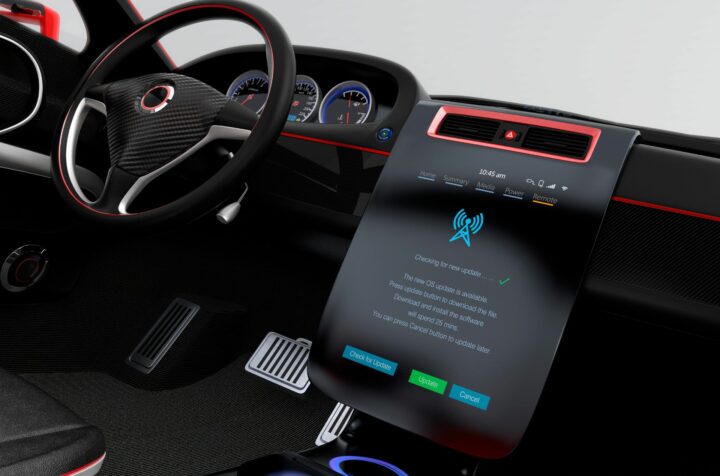The automotive industry has come a long way since the first cars rolled off those early assembly lines in the early 1900s. The Model T’s fastest speed was 68 kilometers (42 miles) per hour (though, considering the lack of modern roads, comfort, and safety features that was surely terrifying enough). They didn’t have seatbelts or windshield wipers and used gas lamps for headlights. Shock absorbers were an aftermarket accessory. While the originals came in several colors, in 1914, all cars were officially black.
Fast forward over a hundred years and now we’re spoiled for choice. Colors, shapes, sizes, types of engines, and fuel. Whatever your need or lifestyle it’s a sure bet that you’ll find a car to fit it. Soon, it’s likely that a customer will be able to select nearly every feature that makes up their vehicle.
That’s because the industry has always been about change. Especially as third-party technologies have evolved. Once it was radios, then 8-track cartridges. Then tape decks and CD players. Today, new cars often don’t even come with a CD player. Music is streamed from the customer’s smartphone (or plugged into a USB port) and GPS is updated at a service center or via an over-the-air update.
Such changes can happen overnight. That’s why manufacturers must quickly incorporate the latest technologies into their builds. But as everything becomes more interconnected, the complexities are growing. Such innovative digital solutions are already challenging the industry, but through them, it’s possible to provide a positive customer experience that lets you stand out from the competition. Knowing what’s on the horizon can be a game-changer.
What then, are some of the big trends to look out – and prepare – for?
The top automotive trends to consider in 2022… and beyond
From parking and reversing assistance, adaptive cruise control, to heads-up displays, drowsiness detection, voice controls, and blind-spot warning, vehicles are steadily becoming smarter.
This trend will only increase in the years ahead as the in-car experience becomes a larger consideration point when a customer purchases their new vehicle – and manufacturers incorporate far more digital technology into their cars and bikes (especially the more innovative electric vehicles).
It’s all about the digital experience
Once upon a time, a minor change was significant – both to manufacturers and their customers. Tapes to CDs. FM to DAB+ to streaming. A static red warning light versus a digital countdown (such as when you need to fill up your AdBlue solution). Yet such changes tended to come in a logical progression. New tech came with a new vehicle.
This is all changing as fast-to-develop digital solutions, which are predominantly based on satisfying ‘immediate’ customer expectations, enter the market. People want solutions that are as easy-to-use, seamless, connected, and as dependable as what they use every day, such as their smartphones and tablets. In many ways, they expect their in-car experience to be the same. Internet on-demand, music as – and when – they want it, and infotainment systems that work without interruption.
The digital experience is becoming as important as the handling of the vehicle, its look, safety, and reliability. Not in the next model of their car in a year or two. Now.
Being able to effectively provide such immediate positive experiences is a true key to success. This will see a rise in closer partnerships with innovative ‘experience’ developers.
Especially as we have never been more connected.
Create the ultimate in-car digital experience
Find out how we can help ensure that your digital solutions provide a great in-car experience and deliver a big competitive advantage.
Learn moreConnected cars
This huge rise in digital technology is seeing vehicles become far more connected. Not only can the driver and passengers seamlessly utilize on-demand and online features in their car as easily as using their smartphones, but the vehicles themselves are increasingly collecting (and ultimately sending and receiving) a range of digital data, including over-the-air updates, vehicle diagnostics, and health reports, and even proactive messaging to help prevent accidents and breakdowns.
Cars will communicate with their passengers as easily as they will with the other vehicles around them. Such connectivity and ease-of-use are also being reflected in the surge of shared mobility, and potentially, ‘car-as-a-service’ (CaaS) options.
Sharing the ride
As with the concept of owning your own home, it’s been traditional to look at a car as another investment. That while depreciation will certainly impact any future sale, the money you get back can then go into your newer, and improved, car.
But this mentality is starting to change as the overall return on investment is not being seen as good enough. Shared mobility (or Mobility-as-a-Service) is becoming an alternative to vehicle ownership. Instead of the ongoing costs of owning a car, convenient short-term access enables people to ‘rent’ the car for a specific length of time (and distance) – so there should be no unused cars. It’s a business model that is increasingly being used by new business start-ups and, as it’s already exceeding US$60 billion in value (in China, Europe, and the US), it’s no surprise that cities are seriously considering shared mobility as an alternative/addition to public transport.
This might be just the beginning. A further extension of shared mobility is CaaS; particularly as more autonomous, self-driving transportation gains popularity.
Car-as-a-Service, as with shared mobility, enables a person to rent a car via an app – but without the need to (be able to) drive the car. Additionally, the car can arrive on its own and can even be used to receive deliveries. The potential is highly flexible, especially because the driving is completely autonomous.
Hands-free transportation
Removing the driver from driving is intended to make vehicles safer, more fuel-efficient, and reduce accidents. For industry use, downtime can be minimized and the range of 24/7 deliveries, increased.
While autonomous (and driver-assisted) cars are already on the roads, testing is ongoing, as are the many discussions around overall safety and practicality. For day-to-day customers, being able to purchase an affordable and realistically self-driving car is still years away, but there is no sign of the industry slowing down. Particularly when it comes to trucks.
Self-driving trucks, alone, are projected to reach a global market size of US$1.6 billion by 2025. This is also expected to see a rise in ‘truck platooning’, where multiple trucks are synced together using connective technology and automated systems – resulting in faster reaction times and reduced fuel consumption.
Once they all do become mainstream, it’s clear that they will be filled with digital technologies to keep everything secure and to keep them entertained.
The electric revolution
Latest innovations were traditionally first placed into electric and hybrid cars, from cruise control with automatic distance control to heads-up displays. This is only becoming more so as dashboards become more minimalist but filled with digital solutions. The rise of EV’s comes naturally from concerns over the cost and availability of fossil fuels (plus shortages for additives, such as AdBlue for diesel vehicles) and the health of our environment.
This was summed up in a Forbes article by Thomas Pohl,
“Big and small players in the automotive industry are increasingly feeling the pressure to rethink the way they operate. They must reevaluate everything from the design and engineering stages, through the manufacturing and shipping processes, all the way to how vehicles operate, how they are serviced, and how they are dealt with at the end of the product lifecycle.”
One clear direction for this is the development of electric vehicles.
As they become more widespread, affordable, and able to travel greater distances, adoption is gaining speed. But this is bringing additional challenges, especially regarding the amount of charging stations. With estimates there could be up to 220 million electric cars on the road by 2030, ensuring there are enough (ideally fast charging) public chargers is essential. As are those that are readily accessible at workplaces and in multi-family residences – currently, it’s clear that most EV purchasers live in single-family (detached) houses where they have direct control of the charging station.
As public access continues to grow this will create challenges around e-mobility, especially regarding the digital solutions that track and report on charge status, where charging stations are located, and how much further the EV can travel on any given charge. Ensuring the accuracy of these apps is essential.
Ongoing lockdowns, supply chain shortages, and dropping stock values
In 2020, global automotive sales contracted by roughly 15 percent, even as the entire industry entered a phase of stagnation in 2019. While this is gradually improving, it’s clear that the industry is still on its back foot.
As noted in their article, ‘2022 and the global sales picture’ by David Legett, Just Auto noted that
“GlobalData forecasts that the global light vehicle market in 2021 will total 79.9 million units, just 5.5% ahead of 2020 (75.7 million), with the chips crisis and resultant supply shortages this year contributing to a market around 4 million units below where underlying demand suggests it should have been. For context, the global light vehicle market exceeded 90 million units during the 2016-2018 period (slowing slightly in 2019).
The outlook for 2022 is for the global light vehicle market to grow to around 84 million, but supply and demand issues – as well as ongoing pandemic risks – point to a continuing fragility to the auto industry’s recovery next year. At 84 million units we’re still not quite back to pre-pandemic levels, though.”
The coronavirus pandemic, now with its new omicron variant, shows no signs of ending in the coming months. Previously, this has seen factories close, continuing work stoppages, and various parts shortages. All of which directly impact the automotive industry. As the article above mentions, a substantial issue has been a global shortage of semiconductor chips, which are an important part of many electric devices.
For the auto industry, this is especially relevant as it is estimated that electronic systems will be half the total price of a new car by 2030. One potential way of addressing these problems will be stronger collaborations.
Sharing knowledge and manufacturing capacities
Cross-industry networks are now helping to bring a range of industries together to help with the development of innovative solutions and deal with supply chain issues, sustainability, and multiple e-mobility challenges.
Where one business (or industry) cannot effectively handle a new issue (such as the creation of an integrated hardware and software solution to manage the entire charging process of a new battery), another with specific knowledge can contribute. A third, such as Testbirds, can then provide the comprehensive testing that is required to ensure it works as intended.
The entire industry – all industries – are now having to work smarter.
Truly smart cars – the rise of artificial intelligence
AI technologies are increasingly being used to develop autonomously driving and driver-assisted vehicles, along with fleet management, supply chain sourcing, inspections, and even more peripheral areas, such as financing and insurance. Even within the customer’s collection of Internet of Things devices, voice assistants, and more.
For traditional automakers, AI is set to complement their existing processes and designs. Without effective AI, it will simply be impossible to provide the seamless, fast, and always-ready in-car experience that customers are now demanding. Take BMW’s constantly learning Intelligent Personal Assistant. You can say “I’m hungry” and it will recommend a restaurant. Say “I’m cold” and it will turn on your seat heating. It can tell you everything about the car’s performance and will learn your habits. Without AI, this could not be done.
Collaborations will be essential to ensure that all components work together – from sensors to software (and its development) to the hardware being able to process such massive amounts of data.
Getting it all right is important when it comes to building trust with customers.
Turning challenges into opportunities
There’s no doubt that the next years will be challenging. The way people work has changed. Expectations for connected experiences that make life easier and more comfortable are growing. The complexity to develop such solutions is increasing.
Every customer journey must be unique and work across multiple touchpoints – phone, tablet, in-car infotainment, third-party apps/solutions in the car, and even outside users (mechanics, insurers, police). All while being secure, accurate, good for the environment, and dependable.
This will take strong partnerships (joint R&D), an innovative approach, improving employee skill sets, and thoroughly testing your solutions at every step of its development. Providing such an experience, however, will become a true differentiator and a significant competitive advantage.








